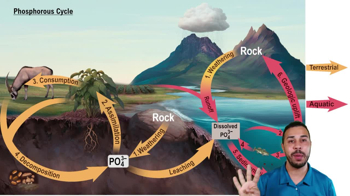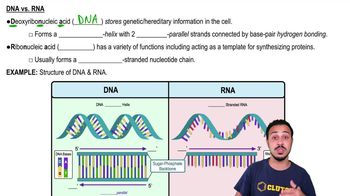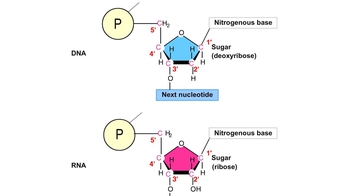Table of contents
- 1. Introduction to Biology2h 40m
- 2. Chemistry3h 40m
- 3. Water1h 26m
- 4. Biomolecules2h 23m
- 5. Cell Components2h 26m
- 6. The Membrane2h 31m
- 7. Energy and Metabolism2h 0m
- 8. Respiration2h 40m
- 9. Photosynthesis2h 49m
- 10. Cell Signaling59m
- 11. Cell Division2h 47m
- 12. Meiosis2h 0m
- 13. Mendelian Genetics4h 41m
- Introduction to Mendel's Experiments7m
- Genotype vs. Phenotype17m
- Punnett Squares13m
- Mendel's Experiments26m
- Mendel's Laws18m
- Monohybrid Crosses16m
- Test Crosses14m
- Dihybrid Crosses20m
- Punnett Square Probability26m
- Incomplete Dominance vs. Codominance20m
- Epistasis7m
- Non-Mendelian Genetics12m
- Pedigrees6m
- Autosomal Inheritance21m
- Sex-Linked Inheritance43m
- X-Inactivation9m
- 14. DNA Synthesis2h 27m
- 15. Gene Expression3h 20m
- 16. Regulation of Expression3h 31m
- Introduction to Regulation of Gene Expression13m
- Prokaryotic Gene Regulation via Operons27m
- The Lac Operon21m
- Glucose's Impact on Lac Operon25m
- The Trp Operon20m
- Review of the Lac Operon & Trp Operon11m
- Introduction to Eukaryotic Gene Regulation9m
- Eukaryotic Chromatin Modifications16m
- Eukaryotic Transcriptional Control22m
- Eukaryotic Post-Transcriptional Regulation28m
- Eukaryotic Post-Translational Regulation13m
- 17. Viruses37m
- 18. Biotechnology2h 58m
- 19. Genomics17m
- 20. Development1h 5m
- 21. Evolution3h 1m
- 22. Evolution of Populations3h 52m
- 23. Speciation1h 37m
- 24. History of Life on Earth2h 6m
- 25. Phylogeny2h 31m
- 26. Prokaryotes4h 59m
- 27. Protists1h 12m
- 28. Plants1h 22m
- 29. Fungi36m
- 30. Overview of Animals34m
- 31. Invertebrates1h 2m
- 32. Vertebrates50m
- 33. Plant Anatomy1h 3m
- 34. Vascular Plant Transport2m
- 35. Soil37m
- 36. Plant Reproduction47m
- 37. Plant Sensation and Response1h 9m
- 38. Animal Form and Function1h 19m
- 39. Digestive System10m
- 40. Circulatory System1h 57m
- 41. Immune System1h 12m
- 42. Osmoregulation and Excretion50m
- 43. Endocrine System4m
- 44. Animal Reproduction2m
- 45. Nervous System55m
- 46. Sensory Systems46m
- 47. Muscle Systems23m
- 48. Ecology3h 11m
- Introduction to Ecology20m
- Biogeography14m
- Earth's Climate Patterns50m
- Introduction to Terrestrial Biomes10m
- Terrestrial Biomes: Near Equator13m
- Terrestrial Biomes: Temperate Regions10m
- Terrestrial Biomes: Northern Regions15m
- Introduction to Aquatic Biomes27m
- Freshwater Aquatic Biomes14m
- Marine Aquatic Biomes13m
- 49. Animal Behavior28m
- 50. Population Ecology3h 41m
- Introduction to Population Ecology28m
- Population Sampling Methods23m
- Life History12m
- Population Demography17m
- Factors Limiting Population Growth14m
- Introduction to Population Growth Models22m
- Linear Population Growth6m
- Exponential Population Growth29m
- Logistic Population Growth32m
- r/K Selection10m
- The Human Population22m
- 51. Community Ecology2h 46m
- Introduction to Community Ecology2m
- Introduction to Community Interactions9m
- Community Interactions: Competition (-/-)38m
- Community Interactions: Exploitation (+/-)23m
- Community Interactions: Mutualism (+/+) & Commensalism (+/0)9m
- Community Structure35m
- Community Dynamics26m
- Geographic Impact on Communities21m
- 52. Ecosystems2h 36m
- 53. Conservation Biology24m
4. Biomolecules
Nucleic Acids
Problem 7b
Textbook Question
Textbook QuestionA shortage of phosphorus in the soil would make it especially difficult for a plant to manufacture a. DNA. b. proteins. c. cellulose. d. sucrose.
 Verified step by step guidance
Verified step by step guidance1
Identify the role of phosphorus in plants: Phosphorus is a key component of nucleic acids, including DNA and RNA, which are essential for genetic information storage and transfer.
Understand the molecular structure of DNA: DNA is composed of nucleotides, each containing a phosphate group, a sugar (deoxyribose), and a nitrogenous base.
Recognize the importance of phosphorus in DNA: The phosphate groups in the nucleotides link together through phosphodiester bonds to form the backbone of the DNA double helix.
Analyze the options given in the question: Determine which of the options (DNA, proteins, cellulose, sucrose) directly involves phosphorus as a critical component of its structure.
Conclude which process would be most affected by a phosphorus shortage: Based on the role of phosphorus in nucleic acids, decide which of the listed molecules' synthesis would be most impacted by a lack of phosphorus in the soil.
Recommended similar problem, with video answer:
 Verified Solution
Verified SolutionThis video solution was recommended by our tutors as helpful for the problem above
Video duration:
1mPlay a video:
Was this helpful?
Key Concepts
Here are the essential concepts you must grasp in order to answer the question correctly.
Role of Phosphorus in Plants
Phosphorus is an essential macronutrient for plants, playing a critical role in various physiological processes. It is a key component of nucleic acids (DNA and RNA) and ATP (adenosine triphosphate), which is vital for energy transfer within cells. A deficiency in phosphorus can hinder a plant's ability to grow and develop properly.
Recommended video:
Guided course

Phosphorus Cycle
DNA Synthesis
DNA (deoxyribonucleic acid) is the molecule that carries genetic information in living organisms. The synthesis of DNA requires nucleotides, which contain phosphorus in their phosphate groups. Without adequate phosphorus, plants cannot effectively produce DNA, leading to impaired growth and reproduction.
Recommended video:
Guided course

DNA Replication
Photosynthesis and Energy Transfer
Photosynthesis is the process by which plants convert light energy into chemical energy, producing glucose and oxygen from carbon dioxide and water. This process relies on ATP, which is synthesized using phosphorus. A shortage of phosphorus can disrupt energy transfer, affecting the plant's overall metabolism and growth.
Recommended video:
Guided course

Introduction to Photosynthesis

 3:22m
3:22mWatch next
Master Nucleic Acids with a bite sized video explanation from Jason Amores Sumpter
Start learningRelated Videos
Related Practice

















